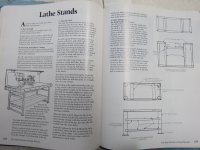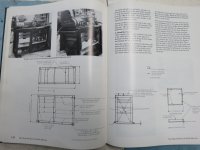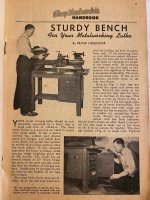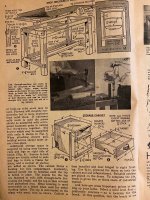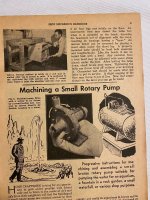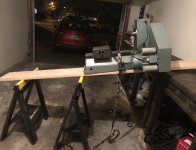I've read about the use of concrete for machine tool bench tops. Over the past 50 years, I have run jobs and designed projects using a LOT of reinforced concrete (the biggest single pour in one day was 1200 cubic yards), and having handled specialized concrete work/repair work on turbine and engine foundations. The use of concrete for a bench top has its pros and cons.
On the plus side: the weight of the concrete will add 'mass dampening' and act as an inertia block to reduce vibration. Concrete weighs 150 lbs per cubic foot.
Also on the plus side: the top can be made to whatever dimensions needed, and 'blockouts' for belting to pass thru, or pipe sleeves for wiring to pass thru can be
built into the forms.
On the minus side: concrete soaks up oil. Also on the minus side: the as-cast surface of concrete is not going to give 'full and complete bearing contact' with the
mounting surfaces on the lathe bed's feet. One way to address this is to make some steel sole plates with 'mud hooks'. The sole plates are pieces of steel plate,
milled flat on the top surface, and could be drilled and tapped for mounting bolts based on the layout of the lathe bed's mounting surfaces. The mud hooks are
pieces of steel bar stock bent at 90 degrees and welded to the underside of the sole plates. The mud hooks anchor the sole plates in the concrete. There is a
homeowner or utility grade of rebar that is made from rerolled scrap steel rather than re-rolled railroad rail. This utility grade is a lot more weldable than the highere strength grades. I'd make the mud hooks out of number 4 ( 1/2" nominal) rebar, putting a 90 degree bend on the and running the horizontal legs out a good 6". Four mudhooks per sole plate. These sole plates then give a solid surface to bolt the bed onto, and also a surface to insert shims to level the lathe.
I'd go with a minimum slab thickness of 4". I'd also put in a grid of number 3 or number 4 rebars. Corners of the rebar 'mat' should be made using bars bent at 90 degrees, with about 8" of overlap where the bars are spliced.
For concrete, I'd suggest a fine aggregate rather than the number 2 crushed stone used in most mixes. For a small pour like a bench top, mixing the concrete on site is the only show in town. The wetter or more flowable a mix of concrete is, the lower the developed strength and the more likely to get curing cracks. For a structural slab, a stiff mix (we go by a measurement known as "slump") is best. It's tempting to use a soupy mix of concrete as it will flow into the forms and around the rebar and other imbed items, and will self-level. However, this temptation is a bad bet to take. A slump test is done on heavy construction projects on each batch of concrete as it starts to come out of the mixer trucks. The slump cone is a truncated cone made of sheet stainless steel, 12 inches tall. It looks like a kid's sand pail with the bottom cut out of it. To do a slump test, when the mixer truck has put a trial amount of water into the bowl of the mixer and given it some turns, a small amount of concrete is startred down the delivery chute and into a wheelbarrow. The slump cone is placed on a level sheet of plywood or steel plate, big-end down, small end up, and about 1/3 of its height is filled with concrete. This is rodded (worked or compacted) with a 1" diameter steel rod, 12 shots, uniformly spaced. The next third of the cone is filled with more concrete, and it is rodded in the same manner, and then the cone is filled to the top and rodded. Any additional concrete to bring the level up over the top of the steel cone. This is then struck off with the steel rod. The slump cone is then carefully lifted straight up in one continuous motion. It is like a kid making sand castles at the beach with an inverted sand pail. The steel slump cone is then stood adjacent to the concrete 'cone'. The steel rod is laid on top of the slump cone so that extends over the top of the concrete 'cone'. A folding rule is then used to measure how far the concrete has 'slumped' from the 12" height of the steel slump cone. A slump of 2 1/2-3" is a stiff mix, and what we'd always call for on structural concrete, even with a forest of rebar and plenty of imbed items like anchor bolts or sole plates. For a bench top, it is a small flat pour, so working a stiff mix should not be an issue.
For attaching the concrete top to the steel legs, some steel imbeds with more mudhooks would work well. I hesitate to suggest anchor bolts such as expansion shields or wedge type bolts. This is because the slab is relatively thin. By using imbeds with mudhooks, concentrated loads and potential pullout failures of anchors holding the legs or the lathe bed are pretty well eliminated.
Once the top is poured, after the initial set, the concrete can be steel trowelled to smooth finish. If the imbed sole plates are used, the flatness of the slab top is not so critical. If desired, the slab top could be finished with a very slight pitch with the imbed sole plates for the lathe bed as the high point, and the finished concrete pitched downhill to the edges of the slab top. This would prevent pocketing cutting oil and similar and make cleanup a little easier. Some steel flatbar could be used for forming the perimeter of the slab. Using steel flat bar a little taller than depth of slab would create a 'chip pan'. I'd weld mudhooks (more correctly known as "shear anchors") to the inside surface of the steel flat bar. This would tie the steel flatbar to the concrete, and add more strength to the overall slab top.


 .
.